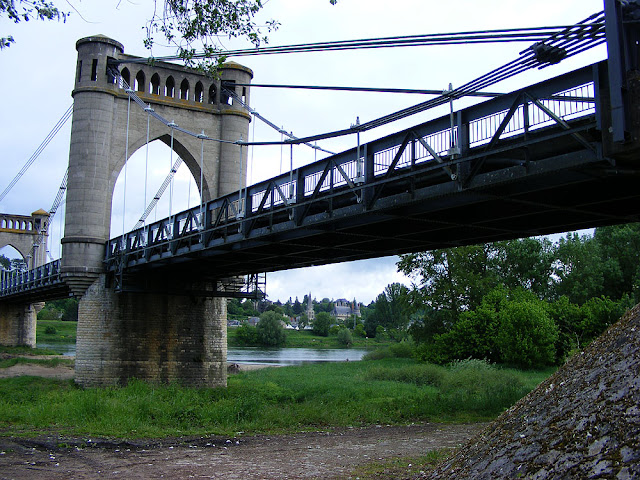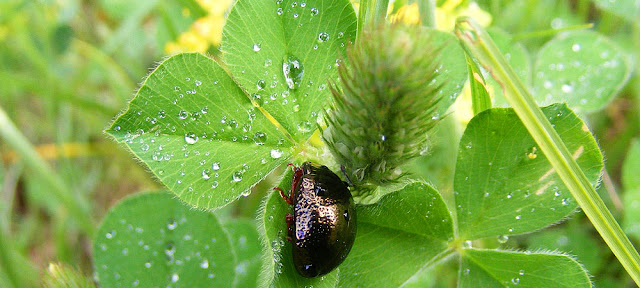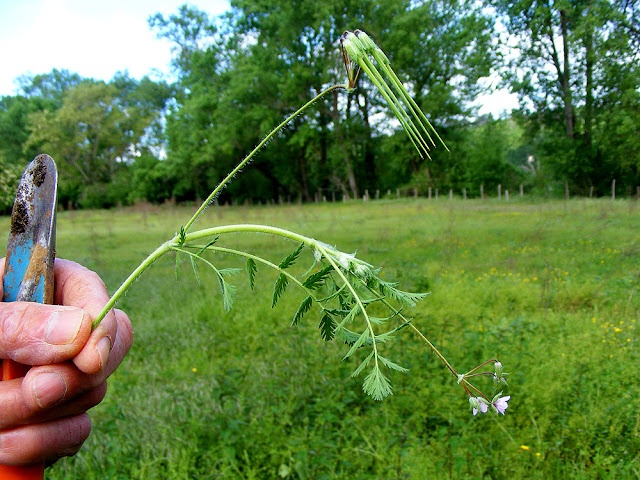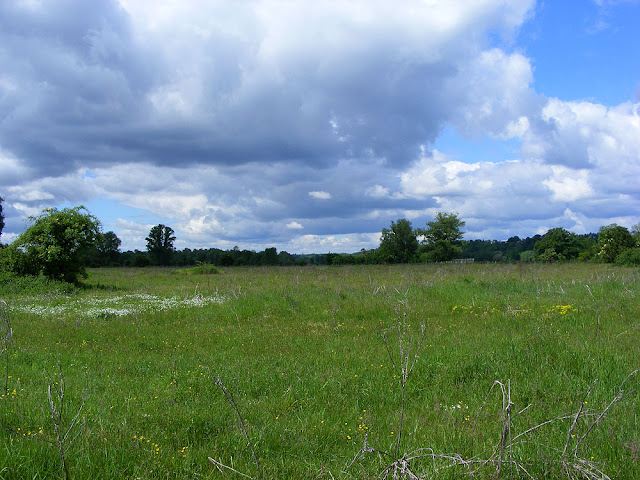Saturday 11 May saw me heading off to Langeais to meet Chantal and Dominique and whoever else turned up at the carpark under the southern side of the Langeais suspension bridge. The outing was to be an exercise in learning about the flora of a Loire water meadow, and it turned out to be way more interesting than I expected. Dominique is a great teacher -- knowledgeable about all sorts of little botanical details and patient enough to make sure I've understood, seen and had time to photograph. It was a great site because there were lots of examples of two (or more) species in a genus, enabling lots of comparing and contrasting. What follows are some general photos from the morning, but I am planning to do a series for Loire Valley Nature covering pairs of similar species that we saw on site (bromes; geraniums; forget-me-nots; bugles; buttercups; storksbills; sandworts, stitchworts, chickweeds and mouse-ears; fescues).
The 19th century suspension bridge over the Loire at Langeais (the town on the other side you can see). This is the only suspension bridge over the Loire that survived the Second World War. Apparently when I say I'm going to Langeais, a French person can't tell if I'm coming here or going to Lingé.
The leaf beetle Chrysolina banksii (Fr. le Chrysomèle de Banks), on Crimson Clover Trifolium incarnatum subsp incarnatum (Fr. Trèfle incarnat). The clover is native to this area and growing wild, not as an improved pasture assemblage -- this water meadow is native grasses, legumes and wild flowers, extensively grazed by the favoured local breed of cattle, Limousin. Reassuringly sustainable and traditional. This beetle species is tricky to identify if you are a beginner, but once you know what to look for, is not too much of a problem. It is widespread and quite commonly encountered, especially on damp sites.
Upright Bugle Ajuga genevensis (Fr. La Bugle de Genève) and Cypress Spurge Euphorbia cyparissias (Fr. Euphorbe faux cyprès). I'd never heard of this species of Bugle and assumed it was a particularly attractive colony of the commonly encountered Bugle A. reptans. However, Dominique pointed out that the open habitat (as opposed to forest edge) was a clue, and the leaves are a different shape.
The storksbill Erodium cictarium subsp bipinnatum (Fr. Bec-de-grue poilu), showing the striking seed pods and pale dusky pink flowers. Both it and the regular species grow on the site.
A close up of the extraordinary seeds of the storksbill, with a spring to propel it out.
Migrant Corollae Eupeodes corollae (Fr. Le syrphe des corolles ) on Dovesfoot Geranium Geranium molle (Fr. Géranium à feuilles molles).
A female drone fly Eristalis tenax (Fr. Eristale gluante) on Spurge Euphorbia sp. She can be identified by her widely separated eyes, dark facial stripe, vertical lines of hairs on her eyes and dark front feet and hind tibia.
The very rare and localised mouse-ear Cerastium dubium (Fr. Céraiste douteux). It grows in a species assemblage of Annual Meadow Grass Poa annua and Hairy Buttercup Ranunculus sardous, where they are often found together in a damp depression. Their six teeth on the seed capsule is diagnostic.
Botanists at work (Danielle, Dominique and Chantal).
The sawfly Tenthredopsis cf stigma, nectaring on Leafy Spurge Euphorbia esula (Fr. Euphorbe âcre). This spurge species is very localised, mostly only occurring on the Loire sands.
The weevil Phyllobius betulinus. The French for weevil is un charançon. This species can be identified by its dense large blue-green gold scales on its upper side and thighs (except for the bases of the thighs, which are black), spurs on all thighs. It is known to be present in Indre et Loire and I think is probably quite abundant.
The site, a water meadow with sandy soil and natural vegetation, grazed by cattle. It sits between the levee bank to the south and the river on the north, near the bridge at Langeais. It is part of a site known as Ile aux boeufs and La Chapelle aux Naux which is not open to the public and managed by the Regional Conservancy for Natural Spaces. There are plenty of rabbits on site, so I got mercilessly teased by Christiane, who rescued my red plaid sweatshirt last year from the rabbits, after I dropped it on a botany outing.
A Mediterranean Spotted Chafer Oxythyrea funesta (Fr. Cétoine grise) on a buttercup Ranunculus sp.
************************************************
For details of our private guided tours of chateaux, gardens, wineries, markets and more please visit the Loire Valley Time Travel website. We would be delighted to design a tour for you.
We are also on Instagram, so check us out to see a regularly updated selection of our very best photos.
We are also on Instagram, so check us out to see a regularly updated selection of our very best photos.














2 comments:
Wow! Such richness! Would you call that real biodiversity? Glad the meadow is protected.
Stunning photos. Thank you, Susan.
It's a very rich site botanically, and I would assume, entomologically.
Post a Comment